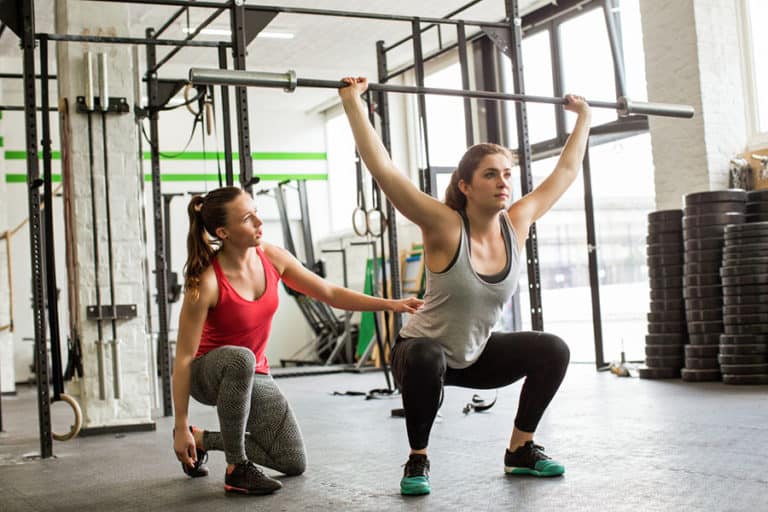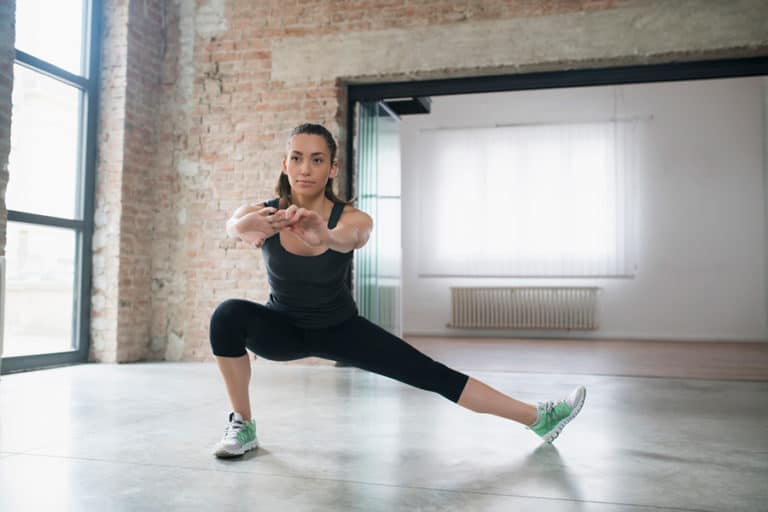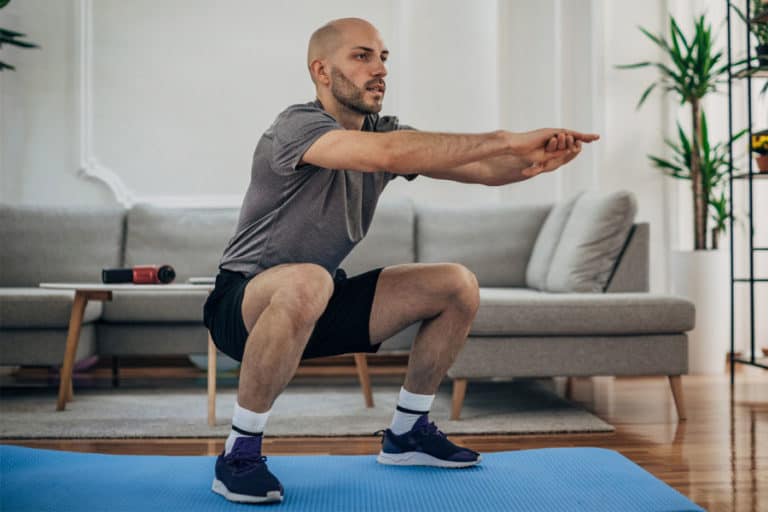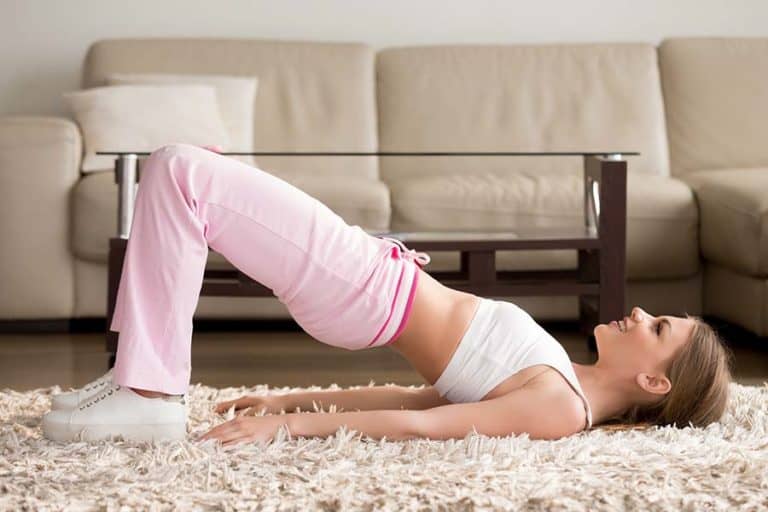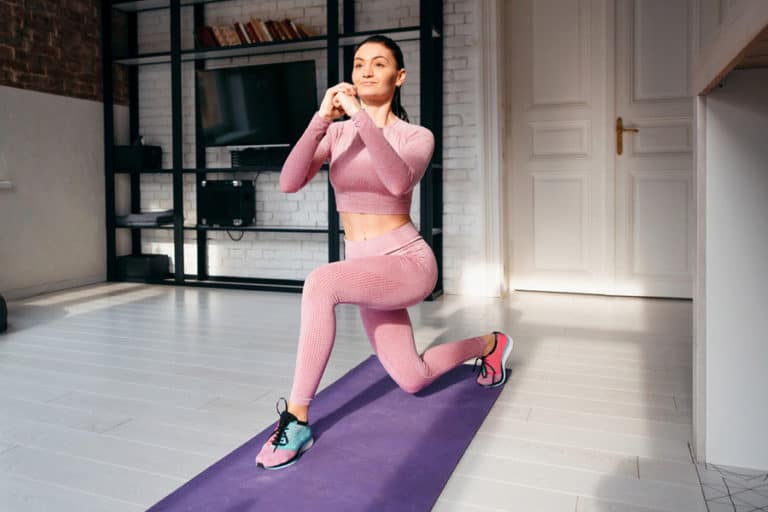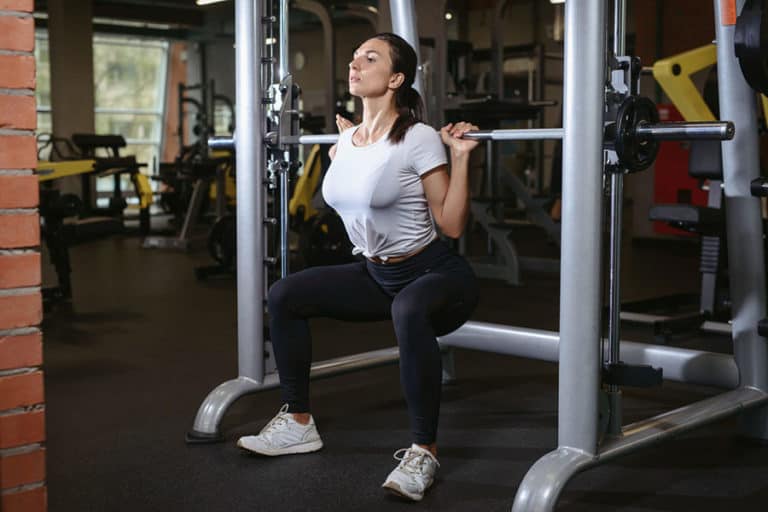Single Leg Squat – How to do, Benefits and Safety Measures
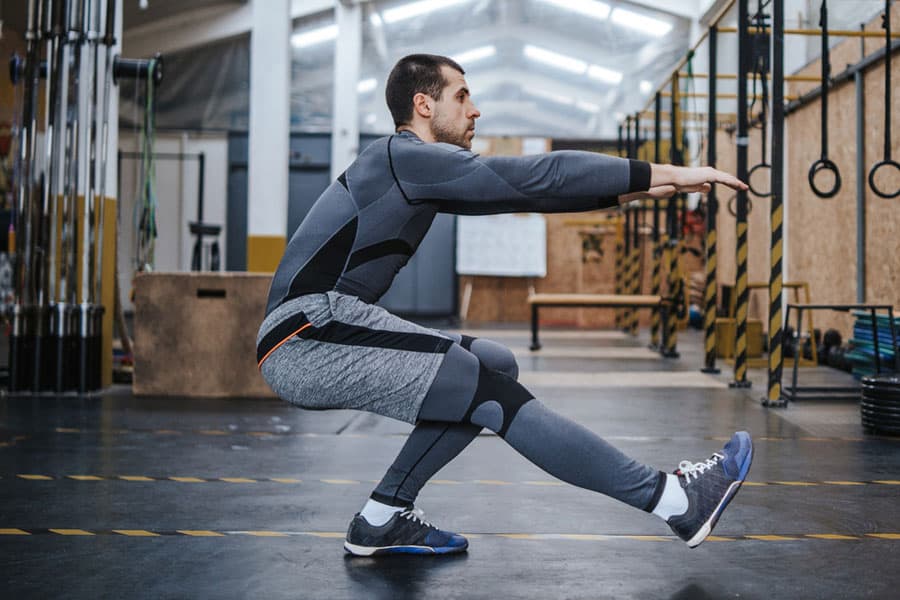
How to do | Muscles worked | Who Should/Should Not | Add to routine | Safety Tips | Benefits | Variations
Single-leg squat, also known as the one-leg squat, is a unilateral variation of the basic squat exercise. It works your body in the sagittal plane (anatomic plane that divides the body into left and right halves).
As compared to other squats, the movement pattern of this squat involves one leg being elevated in front of you as you squat down bending the other. It primarily works the leg muscles to improve your balance, strength, mobility, and core stability.
How to do a single leg squat?
It is essential to perform the exercise in the proper squat form. Here is a step-by-step guide on how you can do a single-leg squat:
- Start by standing with your feet slightly lesser than shoulder-width apart.
- Straighten your back by rolling your shoulder blades back.
- Shift your body weight onto your right foot and raise your left leg straight out in front of you.
- You may place your hands in a neutral position or extend them in front of you to acquire balance.
- Keeping your torso upright and core muscles engaged.
- Begin to sit your hips down as you do in a half squat position (for beginners), or squat until your thighs are parallel to the ground (for intermediates) and keep your knees in line with the toes.
- To drive up, push through your right leg until you reach the starting position. It is best to keep your left leg up through all the reps you perform on that side.
- Once you are done performing the required number of reps on the right side, come into a standing position and switch to the other leg.
Muscles worked
Squats are compound exercises [1]Australian Fitness Academy: WHAT ARE COMPOUND EXERCISES?, i.e., they work multiple muscles and joints simultaneously. The single-leg squats are a variation of the traditional squats. Given below are the muscles that get worked while performing the single-leg squat:
Primary muscles worked
| Quad muscles | vastus medialis, vastus lateralis, rectus femoris, vastus intermedius |
| Butt muscles/ Glutes | gluteus maximus, gluteus medius, gluteus minimus |
| Hamstrings | semitendinosus, biceps femoris, semimembranosus |
Secondary muscles activated
| Abdominal muscles | external obliques, internal obliques, pyramidalis, rectus abdominis, transversus abdominis |
| Hip flexors | iliacus, psoas, pectineus, and sartorius |
| Calf muscles | gastrocnemius and soleus |
Who should and should not do?
The one-leg exercise can be a challenge for some and easy for others. Thus, it is important to know whether the single-leg squat should be a part of your exercise routine. Here are certain sets of people who should either include or refrain from including this single-leg exercise in their fitness routine.
Who should do the single-leg squat?
- Individuals interested in working on their muscle imbalances can incorporate the single-leg squat into their exercise routine. Unilateral exercises are known to isolate the muscles and work on muscular imbalances [2]ResearchGate: The integration of unilateral strength training for the lower extremity within an athletic performance programme.
- The single-leg squat is a unilateral exercise commonly used in rehabilitation programs. Due to its cross-education [3]ResearchGate: The cross education of strength and skill following unilateral strength training in the upper and lower limbs abilities, it indirectly stimulates the nonfunctional side of the body, thus improving strength in the injured area.
- The single-leg squat works the muscles in the posterior chain (glutes, hamstrings, erector spinae, and calves). Runners and athletes often need to perform sports that require a strong posterior chain. Hence it can be a useful exercise for athletes.
- As the single-leg squat is a bodyweight exercise, it can be performed by beginners. Hence, those at the starting point of their fitness journey must try to include the single-leg squat in their workout plan.
Who should not do the single-leg squat?
- Individuals who have recently suffered an injury or anyone recovering from surgery must avoid this exercise.
- Anyone with pre-existing medical conditions should perform this exercise under the guidance of a certified personal trainer to ensure safety and proper form.
How to add it to your workout routine?
Adding single-leg squats to your fitness routine can be highly beneficial. It can help you develop the balance required to perform other lower-body exercises better. Given below are the recommended sets and reps of the exercise. Moreover, follow the table below for a sample circuit:
As a stand-alone exercise
Beginner level: 5-7 reps of 2-3 sets (each side)
Intermediate/advanced level: 6-12 reps of 2-4 sets (each side)
In a circuit
Given below is a circuit for beginners:
| Exercise | Reps/time |
| Step-ups (warm-up) | 5 mins |
| Walking lunges | 10-12 reps (each side) |
| Skipping | 5-7 mins |
| Single leg squats | 5-7 reps (each side) |
| Bulgarian split squats | 6-8 reps (each side) |
Here is a circuit for the intermediate/advanced level:
| Exercise | Reps/time |
| Jump Squats | 8-10 reps |
| Burpees | 8-10 reps |
| Dead bug | 10-12 reps (each side) |
| Single leg squats | 10-12 reps (each side) |
| Goblet squats | 8-12 reps |
Note: You may modify the number of sets and reps as per your capacity. If you are at an intermediate/advanced level and interested in a challenge, perform the single-leg squats with weights to provide more resistance. Resistance unilateral training [4]American College of Sports Medicine: Variability in Muscle Size and Strength Gain after Unilateral Resistance Training provides muscle growth, thus improving muscle size and strength, which is an added benefit.
Safety Measures to follow
Although single-leg squats are beginner-friendly (unlike challenging variations like pistol squats), you need to balance your entire body weight on one leg. As such, it is essential to keep certain safety measures in mind before performing the exercise. Here are some tips for performing the exercise safely and reaping its benefits.
1. Use a spotter
It is best to use the services of a spotter if you are new to this exercise. As the single-leg squat requires a certain level of balance, it is advisable for someone to assist you or spot your errors to perfect the form.
2. Keep your back upright
It is imperative to keep your back upright. It is a common mistake for people to round their shoulders to acquire balance. However, this may cause back injury and might also restrict your mobility.
3. Core engaged
It is important to keep your core engaged throughout the move. The engaged core enhances your overall control and stability. This also ensures that your lower back is not strained while you perform this squat.
4. Rest
It is important to take enough rest between workouts for proper muscle recovery. It is best to rest for 24-48 hours before you get into the next workout. This stimulates muscle growth for increased muscle mass.
Benefits of doing single-leg squats
Here are some unique benefits of the single-leg squat that are worth knowing:
- The single-leg squat is a one-leg exercise. Thus it requires you to balance on a single lower limb to perform the exercise. Regularly performing the single-leg squat improves balance.
- The stance also requires you to keep your core engaged for stability and control to execute the exercise. Thus the regular practice of the single-leg squat works on your core stability.
- It is a spine-friendly move compared to other weighted squat exercises. The single-leg squat is a bodyweight squat. Thus the body does not have to carry any other extra load or give stress to the spine. Moreover, its qualities to improve muscle imbalances may help people with back injuries as it has a lesser impact on the spine.
Single-leg squat variations to try
Single-leg squats can be easily modified as per your fitness levels and goals. Here are some variations of the single-leg squat you can try:
1. Single-leg box squat
Also known as one-leg box squat, is a variation that is best for beginners. The mechanics of the squat remains the same; however, to make it easier, place a box behind you as you squat. As you lower yourself into a squat, allow your glutes to rest on top of the box and then drive up. This will give you some support to perform the exercise and improve your balancing skills.
2. Pistol squats
Pistol squats resemble single-leg squats and work the same muscles. However, the only difference between the two is the depth of the squat. While performing a pistol squat, you must squat deeper than parallel to the floor. This is an advanced version of the single-leg squat and can be performed once you have achieved the strength and flexibility to do the complete range of motion.
3. Single-leg goblet squat (to a bench)
To perform the single-leg goblet squat, hold a dumbbell/kettlebell at chest height and hold it with both hands. Continue with the same steps of the single-leg box/bench squat. The weight will work as a counterbalance and provide resistance. This advanced variation of the single-leg squat works your upper body too.
Conclusion
The single-leg squat is an excellent exercise for people looking to improve their balance and stability. It also helps you achieve a strong and toned body. Single leg squats can be easily modified to make it more challenging as you progress with your fitness levels. Remember to keep the safety measures in mind to avoid any injuries.
References
| ↑1 | Australian Fitness Academy: WHAT ARE COMPOUND EXERCISES? |
|---|---|
| ↑2 | ResearchGate: The integration of unilateral strength training for the lower extremity within an athletic performance programme |
| ↑3 | ResearchGate: The cross education of strength and skill following unilateral strength training in the upper and lower limbs |
| ↑4 | American College of Sports Medicine: Variability in Muscle Size and Strength Gain after Unilateral Resistance Training |


